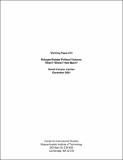| dc.description.abstract | Lack of information about the nature and extent of refugee involvement in political violence has long hindered researchers and policymakers. This paper presents new time series data in order to analyze the frequency, persistence, intensity, and type of political violence involving refugees for the years 1987 to 1998. The analysis reveals a number of interesting, and surprising, trends that contradict the conventional wisdom about refugee militarization. Overall, while absolute numbers of refugees involved in political violence have decreased, the number of states affected remains constant. The difference results from smaller refugee populations becoming involved in political violence. Another significant finding contradicts the assumption that political violence affects most refugee areas. In fact, very few refugee situations experience political violence. In most years, over one hundred states host refugees, yet 95% of all refugee-related violence usually takes place, on average, in fewer than fifteen states. The findings from this dataset reveal trends in refugee-related violence and change the terms of the current discourse on refugees and political violence. | en_US |
